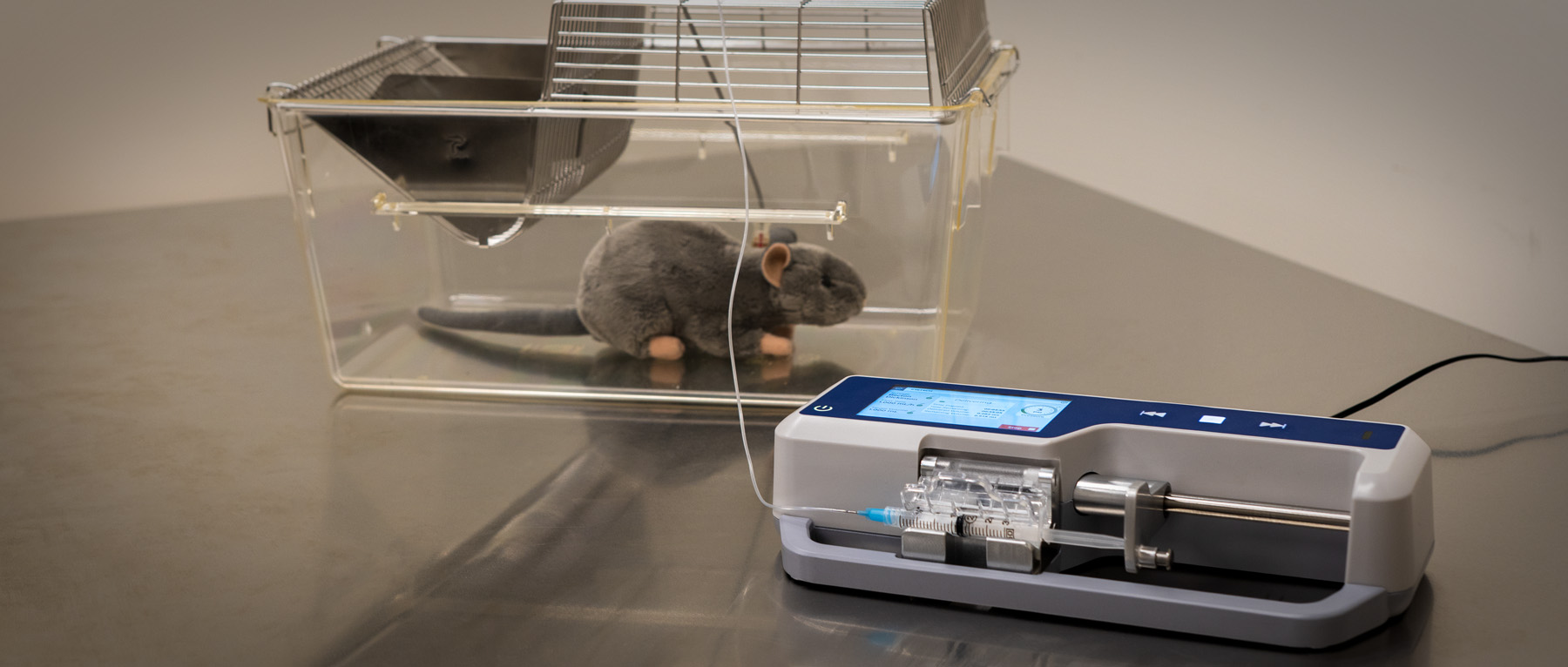Delivering an accurate, consistent dose in preclinical infusion studies requires far more than choosing a pump with an impressive specification. Syringe pumps are often described as the most precise devices for controlled IV dosing in small animals—but true accuracy depends on the entire system: the syringe, the setup, the interface, and the human operating it.
This series explores syringe pump performance from every angle, combining decades of Instech’s experience in preclinical infusion research with practical examples from the field. Each post examines a key piece of the accuracy puzzle—from what “±0.5%” really means, to how user interface design and flow smoothness affect reproducibility and animal welfare.
Whether you’re validating a new dosing protocol, troubleshooting inconsistent results, or evaluating new infusion equipment, this series will help you understand where errors originate—and how modern syringe pump design can eliminate them.
Syringe Pump Accuracy in Preclinical Infusion Studies
 Syringe pumps are often viewed as the gold standard for precise IV dosing in preclinical research—but their published accuracy specs only tell part of the story. Even pumps with ±0.5% accuracy, like Instech’s Model 400 or Harvard’s 11 Elite, can’t compensate for syringe variability, system design, or setup errors that can drastically affect delivered dose. In fact, factors such as syringe ID tolerance, catheter kinks, and siphoning can cause real-world deviations far beyond the pump’s stated precision. This blog breaks down what “accuracy” really means, how syringe and setup choices impact results, and why understanding the entire infusion system—not just the pump—is essential for reproducible research.
Syringe pumps are often viewed as the gold standard for precise IV dosing in preclinical research—but their published accuracy specs only tell part of the story. Even pumps with ±0.5% accuracy, like Instech’s Model 400 or Harvard’s 11 Elite, can’t compensate for syringe variability, system design, or setup errors that can drastically affect delivered dose. In fact, factors such as syringe ID tolerance, catheter kinks, and siphoning can cause real-world deviations far beyond the pump’s stated precision. This blog breaks down what “accuracy” really means, how syringe and setup choices impact results, and why understanding the entire infusion system—not just the pump—is essential for reproducible research.
The Interface Between Syringe Pump and Human
 Even the most precise syringe pump can’t overcome human error. In this second post in our syringe pump accuracy series, we examine the critical interface between pump and operator—the most common source of infusion errors in the lab. From mis-entered flow rates and syringe misidentification to confusing interfaces on older models, simple user mistakes can dramatically alter dose accuracy and compromise animal welfare. The blog also explores how syringe detection technology, intuitive touchscreens, and intelligent safeguards—like those built into Instech’s new Model 400—help reduce risk and improve reliability.
Even the most precise syringe pump can’t overcome human error. In this second post in our syringe pump accuracy series, we examine the critical interface between pump and operator—the most common source of infusion errors in the lab. From mis-entered flow rates and syringe misidentification to confusing interfaces on older models, simple user mistakes can dramatically alter dose accuracy and compromise animal welfare. The blog also explores how syringe detection technology, intuitive touchscreens, and intelligent safeguards—like those built into Instech’s new Model 400—help reduce risk and improve reliability.
Syringe Pump Performance at Low Flow Rates
 When infusing mice at ultra-low flow rates, as with microdialysis, precision is everything—and not all syringe pumps are up to the task. This third post in our syringe pump accuracy series examines how different pumps perform at flow rates as low as 0.1 µL/min, where accuracy and smoothness of flow become critical. The post compares clinical, industrial, and laboratory pumps, revealing why clinical models fall short and how design choices like step resolution affect flow consistency. Featuring performance data across multiple pumps, the article shows how Instech’s new Model 400 delivers exceptional smoothness and reliability for low-flow preclinical research.
When infusing mice at ultra-low flow rates, as with microdialysis, precision is everything—and not all syringe pumps are up to the task. This third post in our syringe pump accuracy series examines how different pumps perform at flow rates as low as 0.1 µL/min, where accuracy and smoothness of flow become critical. The post compares clinical, industrial, and laboratory pumps, revealing why clinical models fall short and how design choices like step resolution affect flow consistency. Featuring performance data across multiple pumps, the article shows how Instech’s new Model 400 delivers exceptional smoothness and reliability for low-flow preclinical research.
Syringe Pump Performance When There is an Occlusion
 Even with perfect surgical technique and maintenance, occlusions are an inevitable part of infusion studies—and how your pump responds can make or break your data. This post examines how different pumps detect and manage occlusions. Study results show major differences in response time and safety between pumps depending on both mechanics and technology.
Even with perfect surgical technique and maintenance, occlusions are an inevitable part of infusion studies—and how your pump responds can make or break your data. This post examines how different pumps detect and manage occlusions. Study results show major differences in response time and safety between pumps depending on both mechanics and technology.
Conclusion
Achieving true syringe pump accuracy in preclinical infusion studies requires understanding far more than a pump’s stated specifications. From the mechanical precision of the device to the syringes, interfaces, and user interactions that define real-world performance, every detail matters. By examining how these factors influence dosing precision, researchers have the knowledge to design more reliable studies, protect animal welfare, and generate accurate reproducible data.

